From Vacant to Vibrant: Adaptive Reuse Revitalizing the Great Lakes
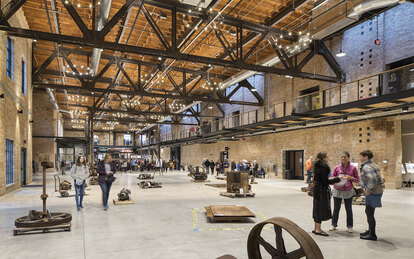
An expert panel shares how adaptive reuse is helping Great Lakes communities reduce carbon emissions, unlock redevelopment funding and enhance community identity.
In cities across the Great Lakes region, a quiet transformation is underway. Formerly vacant buildings — from arcades and schools to factories and train stations — are being reimagined and reutilized as vibrant community anchors. This isn’t just about nostalgia or aesthetics. It’s about reducing embodied carbon, advancing impact-driven capital and reaffirming local culture. It’s about building smarter, investing more thoughtfully and honoring the stories embedded in our built environment.
For the recent International Downtown Association panel From Vacant to Vibrant: Adaptive Reuse Strategies for the Great Lakes, I joined experts from across the region to explore how adaptive reuse is helping communities reduce emissions, unlock funding and reconnect with their sense of place and shared identity. These insights offer a roadmap for cities everywhere.
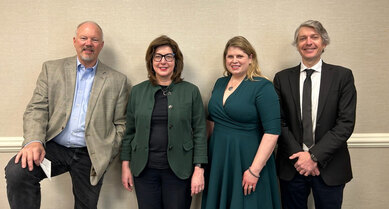
Panelists at IDA Place Matters Conference in Cleveland, from left to right: Dave Williams, Vice President, Development, Cross Street Partners; Kristina Scott, Vice President Strategy, Downtown Dayton Partnership; Melissa Milton-Pung, Policy Research Labs Project Manager, Michigan Municipal LEAGUE; Dan Kinkead, Director of Urban Design, SmithGroup
Building Smarter by Reusing What We Have
The environmental case for adaptive reuse is compelling. In the U.S., 40% of all consumer raw materials are associated with the building industry. Demolition alone accounts for 90% of all debris generation. That’s 145 million tons of waste sent to landfills each year. But the impact isn’t just environmental — it’s emotional. Demolition reduces a community’s sense of shared identity and memory of place. Adaptive reuse helps preserve that connective fabric.
Tools like the CARE (Carbon Avoided Retrofit Estimator) help quantify the benefits. It’s a great way to show clients and communities the carbon savings of reuse versus demolition. It reaffirms a values-based argument with data-driven insight.
Projects like Buffalo’s Central Terminal and Madison’s Garver Feed Mill show what’s possible when communities invest in what they already have. These reuse efforts not only reduce carbon emissions but also create spaces that reflect local identity and invite public engagement.
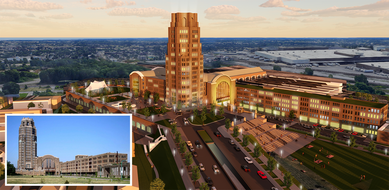
A neighborhood-based adaptive reuse and development strategy for Buffalo, New York’s historic Central Terminal has helped the city leverage over $61 million in project funding.
Funding a Revitalized Future
Adaptive reuse isn’t cheap—but neither is demolition and the cost of a vacant site requiring new construction. Dave Williams, Vice President of Development at Cross Street Partners, shared the story of the Dayton, Ohio Arcade, a 500,000-square-foot complex built in 1904 once slated for teardown. “It would’ve cost $12 million just to demolish it,” he said. “And what do you get? A hole in the ground.”
Instead, the team assembled a complex capital stack that included historic tax credits, New Markets Tax Credits, PACE financing, and public-private partnerships. “We put ice water in our veins and said, ‘Here are the numbers. You make the decision,” Williams recalled.
The result? A nationally recognized redevelopment that’s catalyzing downtown Dayton’s revival.
But funding remains a challenge. “We have a call for $300 million a year in Ohio, but only $60 to $120 million is available,” Williams said. “And even when you win tax credits, the net benefit might only be 6% after all the layers.”
Still, the lesson is clear: with a strong plan, a compelling story and the right partners, adaptive reuse can unlock significant investment.
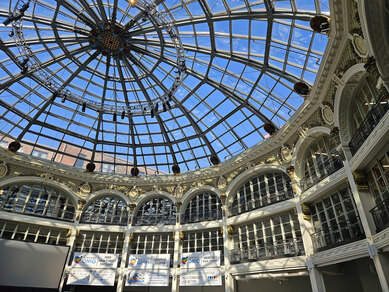
The Dayton Arcade illuminates a larger city plan to bring residents, jobs, and visitors back to the downtown. (Ohio Redevelopment Projects - ODSA, CC BY 2.0 via Wikimedia Commons)
Culture, Community and Charm: The Human Side of Reuse
Melissa Milton-Pung of the Michigan Municipal League emphasized the importance of storytelling and community connection. “You don’t have to make people feel virtuous,” she said. “You just have to show them what’s possible—and make it fun.”
She pointed to projects like the Village at Grand Traverse Commons, a former mental hospital turned mixed-use destination, and the Checker Cab Building in Detroit, now a lively residential and retail hub. “Even if people don’t care about old buildings, they love going there,” she said.
Adaptive reuse also addresses urgent needs like housing. Projects like Emerald Flats in Grand Rapids and St. Mary’s Academy in Monroe, Michigan are creating affordable homes while preserving local heritage.
And it’s not just about buildings, it’s about what happens inside them. “Programming is huge,” said Williams. “If the first floor is active, the building is alive.” From yoga studios to cat cafés, creative uses help draw people in and keep them coming back.
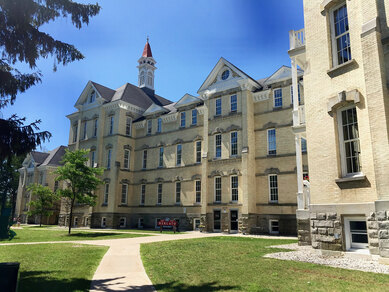
The former Traverse City, Michigan State Hospital evolved to The Village at Grand Traverse Commons, a thriving mixed-use development pairing adaptive reuse with a community of mutually supportive businesses. (w_lemay, CC0, via Wikimedia Commons)
Navigating the Challenges
Adaptive reuse isn’t without its hurdles. Building codes, accessibility requirements and preservation standards can all complicate the process. “Sometimes preservation gets weaponized,” Milton-Pung noted. “We need to protect buildings, yes—but also let them evolve and live in the moment.”
Accessibility is another key concern. “It’s not just about ramps and elevators,” Kristina Scott added. “It’s about making sure everyone feels welcome—especially in cities with histories of redlining and exclusion.”
Collaboration is essential. “A lot of what we do is table-setting,” Milton-Pung explained. “We bring people together who might otherwise be talking past each other.”

Following decades of vacancy, Madison, Wisconsin’s Garver Feed Mill redevelopment exemplifies the revitalizing potential of adaptation, innovation, sustainability and local economic development.
A Call to Reimagine What’s Possible
Adaptive reuse is more than a design strategy — it’s a growing movement and priority for our time. It’s a proven blueprint for reducing carbon, revitalizing economies, and reconnecting communities with their past and future. As Milton-Pung put it, “Every building on the landscape was new once. The question is: do we build to last—or build to throw away?”
In the Great Lakes and beyond, the answer is increasingly clear. With creativity, collaboration, and commitment, we can turn vacant into vibrant—and build places that truly thrive.